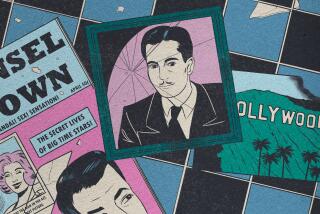Behind the caricatures, real journalists with feelings
Sure, journalists can be pushy louts, too hurried or self-important to worry who gets in their way. But movies and pop culture tend to fixate on the reporter as loud, conniving or politically sold-out, at the expense of images that are much more subtle and true.
Real newsrooms are quiet: keyboards clicking with the sound of details being nailed down, conversation burbling between reporters and editors about what’s fair and, not uncommonly, the journalist speaking quietly into a phone, to console someone who’s lost a loved one.
Reporters understand that they live in a rough and tumble business and that they can’t always make friends. Still, it can be dispiriting to watch the relentless caricature of media running amok.
That’s why it was such a pleasure this week to catch a screening of “Breaking News, Breaking Down,” a documentary that shows journalists as they really are, often struggling with catastrophic events, while trying to maintain the humanity of both their subjects and themselves.
Television anchorman Mike Walter created the short film to show how journalists can be overwhelmed by deep immersion into tragedy and how little attention this phenomenon has received.
The military, law enforcement and firefighting are often cited as the professions that require running toward danger. Walter’s documentary demonstrates, quite movingly, how journalists must be added to that list.
“Breaking News, Breaking Down” shows how reporters and photographers dive headlong toward disaster, seldom imagining that they can be snared in the psychological trauma.
Walter, now 53, began to learn this lesson Sept. 11, 2001, when, caught in traffic on a crowded highway, he watched a gleaming jet plunge into the Pentagon and disintegrate into a fireball.
In the months that followed, he became fixated on stories about victims and loss -- like the piece about a young mother whose husband died that day in the Pentagon. Walter couldn’t help but think that, in a way, he had watched the man die.
The TV man had covered plenty of bloodshed here in the U.S. and overseas in hot spots like Somalia. “I thought, ‘I’m tough, I can take this,’ ” he recalled this week.
But at night he would slip into dark dreams that often ended with a serene outing interrupted as a jet plunged toward some family gathering. During the day, he couldn’t pull out of a fog of depression.
Walter eventually sought treatment. He had understanding bosses at WUSA, a CBS affiliate in Washington, where he was a morning anchor.
But like others in our business he had been taught to focus on the story, so it didn’t really dawn on him that other journalists might be suffering.
Then he met David Handshuch, a photographer in the thick of the World Trade Center collapse, who pointed him toward the Dart Center for Journalism and Trauma. During his subsequent fellowship with the nonprofit center, Walter learned about improving media coverage of traumatic events and supporting journalists who do that work.
Walter then joined the center’s Target New Orleans project, in which journalists from around the world came to support hometown reporters in the hurricane-devastated city.
It was there that he met John McCusker, who epitomized the theme of life overwhelming craft.
A veteran photographer descended from many generations of New Orleanians, McCusker had been one of a hearty core of Times-Picayune newspaper journalists who remained in the flood-ravaged city in the tumultuous days after Hurricane Katrina.
He lost his home in the Gentilly neighborhood, saw his children forced to attend school far from home and struggled to get the funds and permits to rebuild.
Anger and despair -- not only at his own predicament but also at the way his city seemed forsaken -- overtook him.
The photographer had no idea how severe the toll had become until a night in August 2006, when he downed an overdose of psychotropic medication and took off in his car. He caromed off other vehicles and tried to pin a cop with his car, then asked responding police to shoot him.
Only luck and some restraint by the cops kept McCusker alive. The authorities, looking at his clean record and extreme contrition, reduced his offenses to misdemeanors and kept him out of prison.
McCusker, now 46, immediately empathized with the Washington anchor who had suffered through 9/11. They are part of a fraternity of “trauma journalists” who have been hit hard enough by stories to break the profession’s stiff-upper-lip taboo and seek communion with one another.
Walter and McCusker would talk about many things, the photographer told me the other day, including “how to be empathetic and still get the story or the picture. It’s a tight wire that we all walk.”
“Breaking News, Breaking Down,” closes with a shot of McCusker, who still takes pictures for the Picayune, standing on his front porch, blowing away on his clarinet.
Deborah Nelson, a professor in the Merrill College of Journalism at the University of Maryland, said such images have been far too infrequent. Journalists fear, she said, “that if they express any vulnerability, they might be taken off a good story or their careers might suffer.”
Nelson, a former L.A. Times investigative editor who has also served on the board of the Dart Center, said it was heartening to see the outpouring of real emotion from journalists who attended the Washington screening of “Breaking News, Breaking Down” this spring.
The Pulitzer Prize winner, who has written about war crime victims, said journalists appropriately push their subjects into the foreground but go too far to shroud their emotions.
Walter’s film tries to put flesh back on the skeletal outline that most in the media offer of their role.
“We have been our own worst enemies, because we have been encouraged not to show any feeling to each other and to people we write about,” Nelson said. “Whether it’s professionalism or machoism or whatever you want to call it, it hasn’t helped.”
The 36-minute film showed in Pasadena at the Action on Film International Film Festival and drew appreciative audiences as far away as Australia. Walter is looking for a wider airing, hopefully on television but perhaps through journalism schools.
The TV man, who grew up in the San Fernando Valley and attended Cal State Northridge, lost his job this spring in one of the downsizings sweeping the media.
“It’s hard to say losing your job is a good thing,” Walter said. “But I can kind of say that’s true, because I am trying to tell the story of journalists in a way maybe it hasn’t been told before.
“We are impacted by the story. We do have hearts.”
--
More to Read
Sign up for Essential California
The most important California stories and recommendations in your inbox every morning.
You may occasionally receive promotional content from the Los Angeles Times.











